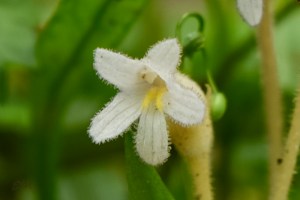 When I finished shooting small-flower phacelia, I just sat and enjoyed the view for awhile, but then the sky darkened and rain looked imminent, so I got all the gear into my daypack and started hoofing it fast back to the car. And then I stopped short, because I saw this.
When I finished shooting small-flower phacelia, I just sat and enjoyed the view for awhile, but then the sky darkened and rain looked imminent, so I got all the gear into my daypack and started hoofing it fast back to the car. And then I stopped short, because I saw this.
I suppose a truly dedicated photographer and botanerd would take the time to set up the tripod and get decent close-up shots, but I hate getting wet, and more importantly I didn’t want the camera to get wet, so I took a few handheld shots and then really started hoofing it fast.
 This is Orobanche uniflora, known by the common names one-flower cancer root, one-flower broomrape, and ghost-pipe; it’s placed in its own family, the Orobanchaceae. It can be found throughout the continental US and most of Canada, in moist woodlands and open areas, often growing right among species of Sedum or plants in the aster and saxifrage families*. In Maryland it can be found from the Appalachian plateau to the western edge of the coastal plain.
This is Orobanche uniflora, known by the common names one-flower cancer root, one-flower broomrape, and ghost-pipe; it’s placed in its own family, the Orobanchaceae. It can be found throughout the continental US and most of Canada, in moist woodlands and open areas, often growing right among species of Sedum or plants in the aster and saxifrage families*. In Maryland it can be found from the Appalachian plateau to the western edge of the coastal plain.
 Notice that the stems are yellow, and there’s no green? That’s because this species has no chlorophyll: it’s parasitic, requiring a suitable host in order to germinate and grow. The leaves surrounding the flowers in these pictures are from other plants. Some of them look to me like one of the asters, though I can’t be sure unless I go back in a few months and see the plants blooming.
Notice that the stems are yellow, and there’s no green? That’s because this species has no chlorophyll: it’s parasitic, requiring a suitable host in order to germinate and grow. The leaves surrounding the flowers in these pictures are from other plants. Some of them look to me like one of the asters, though I can’t be sure unless I go back in a few months and see the plants blooming.
The various Orobanche species are on the federal noxious weed list, and are classified as noxious, prohibited, quarantine, or pest by eight states; Florida excepts O. uniflora, though. It’s hard to imagine this little thing causing significant crop damage, but apparently it can.


Thanks for all the info on this. I just saw it in the Smokies, and didn’t remember seeing it before. Glad to see I correctly identified it.
I’m glad it was useful!